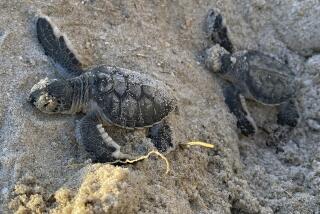Developments in Brief : Green Sea Turtles Bred in Miami Seaquarium
- Share via
Scientists in Florida have succeeded in breeding and hatching endangered Atlantic green sea turtles in captivity, the Miami Seaquarium said last week.
It may be a first in the United States, according to Dr. Gregory Bossart, curator and veterinarian of the Seaquarium.
Nine hatchlings poked their heads out of the sand last Sunday at Seaquarium’s hatching beach, which was built especially for green sea turtle nests. It isn’t known how many eggs were laid in two nests on the beach, but Bossart said a green sea turtle lays an average of 100 to 150 eggs at one time. More hatchlings are expected.
Since 1970 Seaquarium has participated in hatching green sea turtle eggs and raising the offspring until they are big enough to set free in the ocean. The hatching program was called “Head Start” because the turtles, only 1 1/2 inches in diameter after hatching, were grown in captivity until they were big enough to fend for themselves in the ocean. But this is the first time Seaquarium has been able to breed the giant turtles.
Sea turtles lay their eggs during a one-month period starting around the first of June, and babies hatch two months later. In addition to natural predators, young turtles have to cope with crowded beaches, encroaching commercial development and increasing pollution.
A full-grown green sea turtle weighs between 500 and 800 pounds and can live more than 100 years. Bossart said it is not known how old the turtles are when they start breeding, and that the turtles may start breeding earlier when in captivity.
“These turtles will stay at Seaquarium, where we can observe their behavior as they grow, and it may be possible for these hatchlings to breed here one day,” Bossart said.
More to Read
Sign up for Essential California
The most important California stories and recommendations in your inbox every morning.
You may occasionally receive promotional content from the Los Angeles Times.












